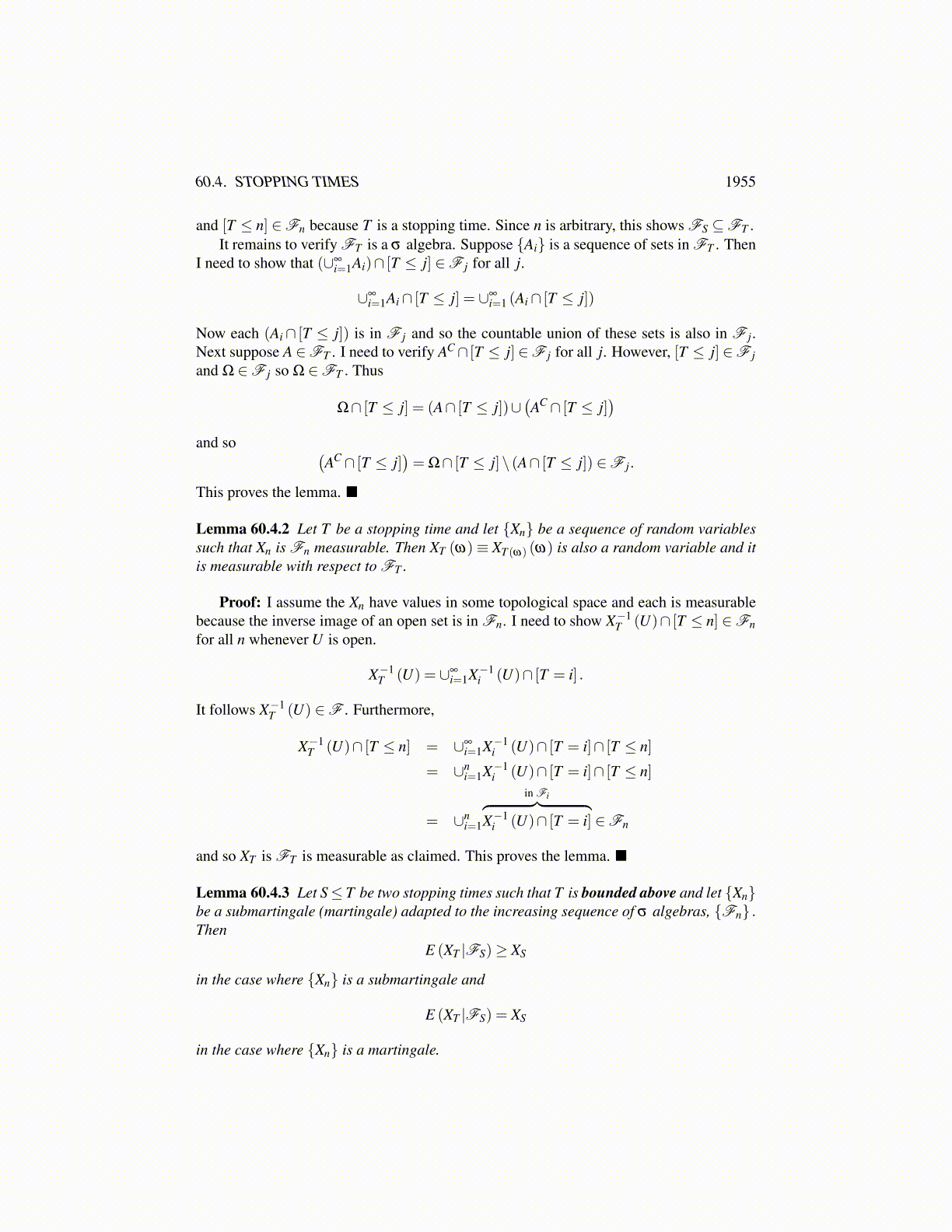
60.3. OPTIONAL SAMPLING AND STOPPING TIMES 1955
2. Typical set in Fi∩ [T = i] is A∩ [T = i] where A ∈Fi. Then A∩ [T = i]∩ [T = j] ∈F j for all j. If j ̸= i, you get /0 and if j = i, you get A∩ [T = i] ∈ Fi = F j soA∩ [T = i] = B ∈FT and so A∩ [T = i]∩ [T = i] = B∩ [T = i] ∈FT ∩ [T = i].
Now let A ∈FT . Then∫A∩[T=i]
E (X |Fi)dP =∫
A∩[T=i]XdP≡
∫A∩[T=i]
E (X |FT )dP
because the set A∩ [T = i] ∈Fi and is also in FT . A typical set in FT ∩ [T = i] = Fi ∩[T = i] is of this form which was just shown above and so, since this holds for all sets inFT ∩ [T = i] =Fi∩ [T = i] , it must be the case that E (X |Fi) = E (X |FT ) a.e. on [T = i] .The last claim is obvious from this. Indeed, if A ∈FT ∩ [T ≤ i] , then it is of the form
A = B∩∪k≤i [T = k] = ∪k≤iB∩ [T = k]
and each set in the union is in Fi∩ [T ≤ i]. For the other direction, if A ∈Fi∩ [T ≤ i] then
A = ∪k≤iB∩ [T = k] ,B ∈Fi,
and each set in the union is in FT ∩ [T ≤ i] . Now note that if A∈FT , then A∩ [T ≤ i]∈Fiby definition and A∩ [T ≤ i]∩ [T ≤ j] ∈F j ⊆Fi if j ≤ i wile if j > i, this set is equal toA∩ [T ≤ i] which is in Fi and so the same argument above gives the result that E (X |FT ) =E (X |Fi) a.e. on the set [T ≤ i] .
One of the big results is the optional sampling theorem. Suppose Xn is a martingale. Inparticular, each Xn ∈ L1 (Ω) and E (Xn|Fk) = Xk whenever k ≤ n. We can assume Xn hasvalues in some separable Banach space. Then ∥Xn∥ is a submartingale because if k ≤ n,then if A ∈Fk, ∫
AE (∥Xn∥|Fk)dP≥
∫A∥E (Xn|Fk)∥dP =
∫A∥Xk∥dP
Now suppose we have two stopping times τ and σ and τ is bounded meaning it has valuesin {1,2, · · · ,n} . The optional sampling theorem says the following. Here M is a martingale.
M (σ ∧ τ) = E (M (τ) |Fσ )
Furthermore, it all makes sense. First of all, why does it make sense? We need to verifythat M (τ) is integrable.∫
∥M (τ)∥ =n
∑k=1
∫[τ=k]∥M (k)∥=
n
∑k=1
∫[τ=k]∥E (M (n) |Fk)∥
≤n
∑k=1
∫[τ=k]
E (∥M (n)∥|Fk)≤n
∑k=1
∫E (∥M (n)∥|Fk)
=n
∑k=1
E (∥M (n)∥)< ∞